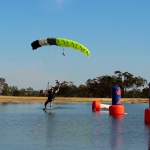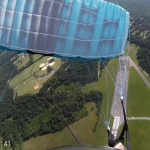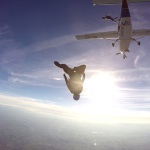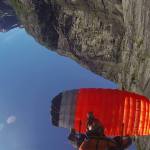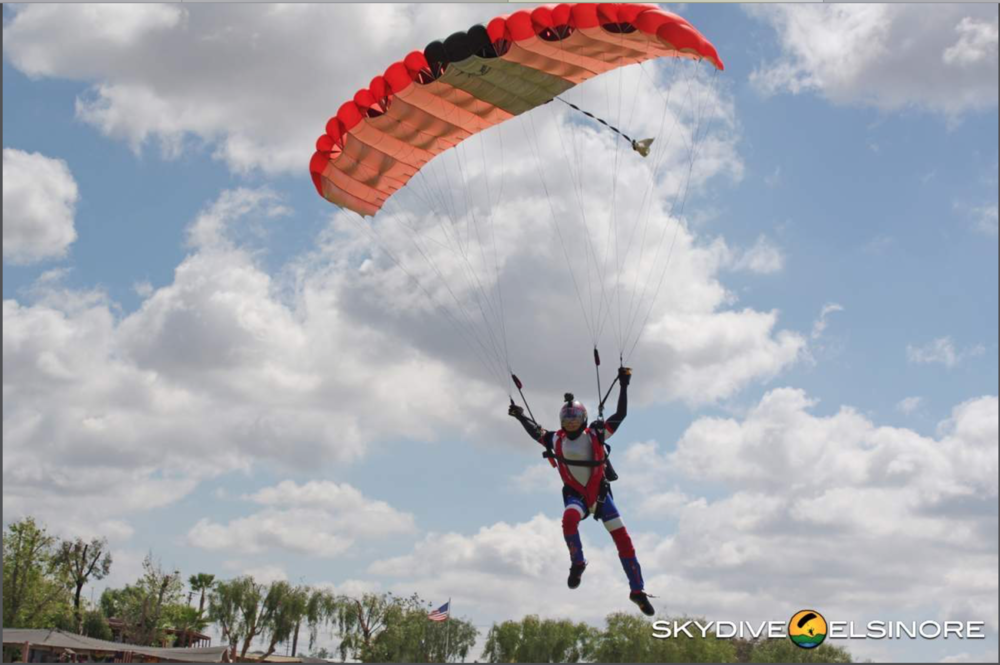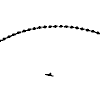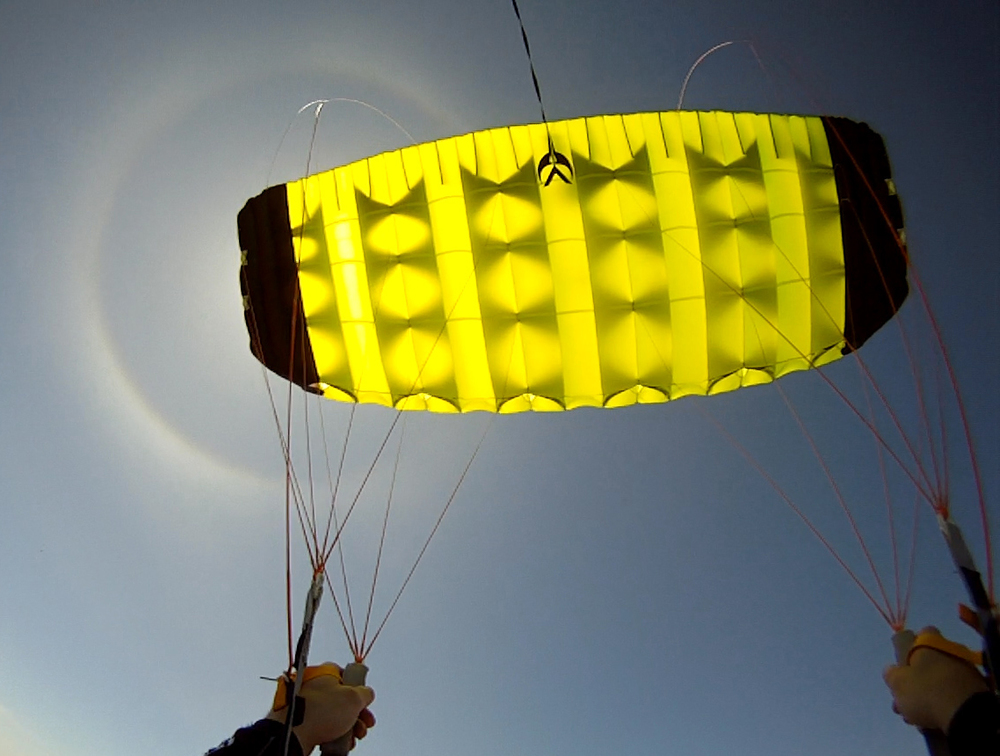Search the Community
Showing results for 'fluid wings'.
Found 119 results
-
Knowing the guys at Fluid Wings, it wont be long until that spot is filled. I
-
I dont know much about it, but assuming the Airwolf is in the same class as a Valkyrie or Leia I would guess that its not aimed at the "first crossbraced canopy" market. Ask Fluid Wings.
-
You want information on the Fluid Wings Airwolf? Go to the Valkyrie Hybrid thread... Seriously though, I'm glad we all have so many options, it's only good for consumers. :-) Still looking for a video from FW on the "easy" way to attach their slider, btw. I can haz?
-
The main benefit of sail is it doesnt stretch on the bias and reduces the chordwise distortion between attachment points. sail is coated with polyurethane or an epoxy, instead of silicone. The crossbraces are zp, (i assume) for pack volume and there is not much of a benefit of sail there. anywhere they can possibly deform, they are taped and reinforced. You will see a slight improvement at first, but then as the coating cracks and flakes off, it will underperform zp. Somewhere between jump 350 and 500 id bet the zp version, side by side will perform better from there on out... If nothing else changes it will not change major flight characteristics. it will simply feel sportier and slightly more responsive.. the recovery arc should actually decrease as you add efficiency and take away distortions, so i dont buy that... This is why fluid wings has developed their own fabric with one of their suppliers, that is both siliconized for longevity and another super secret coating that gives it a little edge over normal zp without the cracking and flaking and pack volume of normal sail cloths. Were calling it FT-30. Its entirely different than sail and more classified as a zp type material, but its also different than anything else out there and showing promise. The airwolf will be available in all zp, FT-30 ribs, and FT-30 ribs and topskin.... just saying I was that kid jumping out if his tree house with a bed sheet. My dad wouldn't let me use the ladder to try the roof...
-
I'm not affiliated with Fluid in any way so don't take this as coming from them. I do chat with some of them from time to time though. I get the impression that some folks didn't like the short-ish recovery arc of the Helix, though it is intended to be that way, so the AirWolf is designed to appeal to that audience. It has been really interesting watching them grow. They really like to play with designs and try new things. Trying to appeal to jumpers across the whole gamut of flying styles and coming from other high performance wings seems to be quite a challenge.
-
Anyone jumped the new Fluid Wings Airwolf yet and care to share their opinion of it? http://www.fluidwings.com/airwolf
-
Yeah, I've been checking out their write ups and vids and it sounds great. As nice as the fluid wings guys seem it would be good to have an independent take on things. I'm hoping for Katana like performance without the exciting openings!
-
Fluid Wings Helix 79 / VK79 / Hybrid Leia 79
danielcroft replied to danielcroft's topic in Swooping and Canopy Control
Well, I've sent the Helix back to Fluid Wings. Once I adjusted the way I was packing to promote a faster opening, the wing opened very nicely and was quite controllable. In flight, it's a lot of fun and very responsive, certainly on the same level as the VK and Leia. I'd say it lands more like the Leia but with a shorter recovery arc. The shorter recovery arc requires more precision that I'm not super good at providing the wing. Rears feel strong when you get it right, although it doesn't shut down as well as the VK for me. I'd say the Leia and VK are more similar than the Helix and VK in terms of the way they fly so, if you've been considering a wing in this category and feel that the Leia suits you better, you'd be doing yourself a huge disservice in NOT demoing the Helix. I love flying different wings so, I'd say the same even if you preferred the VK to the Leia but, you know, you're all grown ass people. For me, keeping in mind the limited experience I have on the Leia and Helix, I'd probably have to say I'd take a Leia over the Helix because I seemed to gel with it a little easier but I don't feel like the Helix is worse by any means and, people sensitive to faster openings should put the Helix at the top of their list, IMO. If I factor in the wait times on the Leia, I'd *actually* order a Helix. YMMV. -
The Sabre2 is solid, I would even say the "gold standard" to which other non-swooping 9cells are measured against. But that also makes it popular, and preserves its used price. 170 is also the most popular size of any non-swooping canopy from what I hear. Other new/intermediate fun jumper canopies include the Pilot (Aerodyne), Pulse (PD), and Prime (Fluid Wings). They will all be tamer than the Sabre2 and you will be disappointed by the flare of all 3 if you are use to the Sabre2 (assuming the one you have been jumping isn't ragged out). I've jumped all three and have nothing but good things to say about all of them. A little off the radar is the Firebolt (Parachute Labs / aka Jump Shack). It is the only canopy I've flown that has a more powerful flare than the Sabre2, it is obvious why, the brake lines affect a larger portion of the tail. As far as flight characteristics (it's been awhile since I jumped one) but it is in the same ball park as the Sabre2 and would feel familiar. The snivel is quite long also. If you can find a 7 cell cheap, the Spectre and Storm are good options (PD), I've heard a number of people say they love the Triathlon (Aerodyne) as well but I have no personal experience. I'm sure someone will disagree, but I wouldn't turn you away from a 7cell, but I would also tell you not to hunt for one. They are much more stable in flight and generally lack the forward speed of 9cells. If that is something someone is looking for (some wingsuiters for instance) that's fine. But it is a bit of a crutch. Anecdotally, I've seen people come from long first runs on 7cells and when they get something sportier (Sabre2 for instance) they are intimidated by the speed and responsiveness. There is an adjustment period as it were, I have not seen the same for people going from a 9cell to a 7cell, other than "Wow, this is much tamer than what I am use to."
-
I like the setup on Scott Roberts / Fluid wings RDS. It takes some getting used to attaching it, but the release is soft, fast and never hangs up on the rings.
-
PD Valkyrie comparison to NZ JPX Leia
mchamp replied to topspark101's topic in Swooping and Canopy Control
Should also add in the Helix from Fluid Wings to compare! For info regarding lift ticket prices all around the world check out http://www.jumpticketprices.com/dropzones.asp -
Fluid Wings Prime I was that kid jumping out if his tree house with a bed sheet. My dad wouldn't let me use the ladder to try the roof...
-
2-piece / detachable slider for general canopy
craigbey replied to RichyR's topic in Gear and Rigging
Good point about the OP's location and ordering the Lookma-RDS. Although the Fluid Wings RDS attachment mechanism is a bit 'fiddly' (as aptly described by another poster here), it's still a good system. It just takes some practice. I removed / re-attached that thing 4-5 times at home before jumping it. -
The cat is out of the bag, and this is what the NZ folks are saying: It will be very interesting to compare the Crossfire 3 with the Tesla from Fluid Wings. These 2 look like very serious pre-crossbraced canopies candidates.
-
Fluid wings Tesla is available in 107 and 120's for order on November 15th.... The 135 and 150 hopefully by the end of the month and the 97 will be available shortly after that. https://vimeo.com/189958872 I was that kid jumping out if his tree house with a bed sheet. My dad wouldn't let me use the ladder to try the roof...
-
I looked over your pics. Then I put some thought into the thought processes YOU must be using to produce this stuff and where you think you're going with it. Your approach to this may have some potential. If you dial in your forces beforehand as it looks like you're trying to do the resulting hardware should at least be a lot more refined than mine was by the time you build it. I will tell you what I can if it will help you. Looks like you've got a lot more patience than I did. Every time I built shit I rather brutally forced the object into existence. I knew nothing of sewing. I did that shit with a 50$ portable sewing machine and a bunch of handheld hole punching tools. Broke a million needles before figuring out a crude modular laced construction method that was fast, semi-accurate, and most importantly, indestructible. Build a wingsuit like a buckskin wallet out of 550 spectra line and you could use the suit to tow a truck. Looks like shit, but if you tie off the spectra with a dozen layered surgeons knots using fucking vise grips, guess what: It won't fail. Knots that big DO get fuzzy, though. I think you're on the right track with feeling your way through it with the hardware. I spent far more time refining the armwings than the tail as soon as it became apparent which line of inquiry was going to deliver more results more usably. The big version was a successful use of strut and sail effects. Put simply I had zip-on singleskin wings going from the wrist and trailing edge of a Birdman S-6 all the way to the ankles. The wing ended squared off about 4 inches out, with a line from there to the toe. In practice this worked even more awesomely than I thought it was gonna. Back off on the wings and fly dirty in a flock and the wing just goes limp, folds back out of the way and flutters a little. NO dramatic effects on flyability at ALL. Slightly bumpier due to more loose fabric if you weren't maxed out, but I could still dock cleanly in a flock with it. Max out with the suit and then deliberately pull the little lines taut with your toes, and half the suit turns into a giant angled sail. I flew it once at a major event. Theres a thread around here somewhere. It created a minor buzz when seen in public. I put maybe 70-100 flights on that configuration. Any time I didn't want the wing or complexity, just unzip it, unclip the toecables and the S-6 returned to stock. In time I kept the zipons tucked in a wing pocket as a sort of instant zipon supercharger anytime I wanted a 3.5 minute solo flight. It became basically a daily driver utility option for that suit until the Tony S-bird came out and I won one in a raffle. I eventually cut the wing back to a triangle and deleted the toecables. The thing about the toecables is, fuck up the deployment and you can toss a pilot chute through the loop. The suit was a horseshoe mal waiting to happen. Extremely unlikely, but very, very possible. So flying that hack created a permanent need for extremely careful and deliberate deployment management. To make matters worse that suit had a tendency to make you go head-low during deployment with the wings folded because of all the loose fabric below the waistline which is exactly what you DON'T want if you're trying to keep the pilot chute away from your feet, so it was VERY tricky to fly and always made me nervous. The S and X bird suits were the first suits to hit the market that beat the performance I could get out of that hack. So when I got one, I retired the hack. I still keep it as a backup suit. Heres where I kinda disagree with you about max flight though: If you're doing it right, its actually not that tense, or locked in position, flying the ram-air S-Bird I use as a daily driver. So far, Although it took years of straining in the wrong directions to learn it, the longest flights I've had are ones where I sort of "got the feel" just right and relaxed in a very specific, certain way. I've had flights of 3:15 where I was shaking like a leaf after, because I was trying way too hard and flying it all wrong. End of last season I set a new best of 3:57 while flying with a vicious leg cramp. I was laid out wide and flat and "sprawled out" the way a suit the size of an S lets you do, while mostly focussed on trying to relax that damn cramp or at least keep the cramp managed enough that the leg doesn't lock or fold on me entirely. I was distracted as all hell, thought I'd already blown the time attempt and just spent the whole flight staying as sprawled as I could while trying to relax that one muscle while still keeping my legs out and toes pointed. I wasn't overthinking the "max out the suit" thing. I didn't think I'd beaten my own record until I watched the video after I landed. Because I was distracted I wasn't trying too hard, and I wasn't even all that fatigued out after that flight nor was I shaking or experiencing any extreme muscle fatigue. And this was with an off-the-shelf factory Tony suit. The most effective body position, I didn't feel strained, I was just sort of cruising around easy while trying to manage that cramp. Within the "max-performance envelope" of flying like that, it doesn't FEEL rigid or restricted at all. If I pull in a wing I know I'll start to drop faster but the expectation and relationship are very instinctive and very linear. There are a number of "enhanced performance ninja moves" that are somewhat rigid but they're not the only way to get long glide and slow fall out of a suit. Theres what feels like an infinite variety of variations on body positions that have various effects on "max". Because the suit is totally "fluid", you get exactly as much wingsuit action as you feel like engaging and know how to do, controlled by how far out your arms and legs are, and how good you are at fine tuning a rather "general" working body position. With rigid surfaces, control is binary. It is either snapped into place and flying or it is tearing your arm off. A wingsuit can smoothly transition from maxed out to gradually curled up in a ball and not flying without any major abrupt transitions. I was betting on my understanding of this relationship when I tested the lexan stuff. My worst case scenario: curl into fetal position with armwings spread wide and pull legs in to belly... basically sit on the wing in freefall and dominate it with the armwings. This trick got me out of lesser spins in a single snap roll, is useful for regaining control of flopping rodeo passengers, and I figured if that approach to managing a floppy object attached to me works with something as big and draggy as a passenger it ought to work to keep control of a lesser slablike surface. It did. When it got too hard to handle I could just scrunch up and keep flying it anyway. Point is if you want your concept to work and keep the flight feel you're going to need to make your hard surfaces articulated and flexible enough not to significantly impede the movement of the wearer. Let the wearer decide the shape and just shape the surface so its ideal, at the most comfortable flying position of the suit you wish it to be a part of. This is why the superhard ram air suits work as well as they do. Since they take their own shape they tend to self-optimize but still allow fluid movement. So essentially what you're trying to do is pull off a functioning substitute for the wingsuit ram air effect with hard surfaces. Think scaled armor. Overlapping plates. So that the wingshape just smoothly stops being wingshape and ceases to exist the further back you bring your arm. If you design this right, you won't need to worry about it buckling because if the strain got that high you'd just bring your arm in a little since you couldn't hold it out against that wind anyway. Looks like your initial modeling approach lends itself well to being made in such a way. In fact your "out the car window" tests would be very good for this: Heres my suggestion: Right now your results are very binary. Either it is in a narrow working range or it ragdolls your arm against the side of the car. It will do this in flight. What you need is the same thing that makes a wingsuit so fluidly controllable: Segment it so you can just pull your arm in. In practice the result you're looking for is the ability to not just "turn it off" but modulate it. Only extend it halfway and its halfway effective without restricting your range of motion or ability to extend or retract the arm. In practice, making this shape real, strong, snag resistant and effective will be very difficult but CAN be done. What are you using for materials in your models, and what materials would you plan to make a real one out of? Your model looks like some kind of light .010 maybe .015, .020 plastic? The trouble with modeling that way is you spend a lot of time solving construction and materials problems that only approximate or just don't apply to any attempt at a real working model. I strongly suggest next model is made of thin sheet lexan. My tail was made of heavy .220 lexan which was ridiculous overkill but typical of the way I build brute force physics hacks. The structures you've made, if made of lexan half that thick simply will not buckle. They'd bend into a U shape under tremendous strain but to date I have never succeeded in loading lexan to a permanent crumple failure like what happened to your wing there. If you made your zigzag wing structure of sheet lexan you'd have to jump up and down on it to even stress it. The machine screws you used to tack it together will shear, but the lexan won't permanently deform unless you drive a screw into it and focus tonnage on a single point. You CAN make lexan crack if you use it wrong or rip the screws through the material. You would have to ditch the panhead machine screws you're using and predrill holes about .010-.015 bigger than your fasteners to allow for metal expansion without cracking the lexan, use stainless buttonhead cap screws and locknuts inside. A wing made that way, you could beat it with a 12-lb sledgehammer without seriously damaging it. And its light... Legal Afterword To Cover My Ass: Anything and everything I say here can and may be inaccurate, and almost certainly will. Any attempt to construct and fly any device based on any advice I may offer here is regarded as suicidal, stupid beyond belief, and is extremely likely to result in death or disability. In essence, everything and anything I say about wingsuit design and construction, if you follow it and do it all right, you're still going to fucking die instantly so do not even think about it. Some, most or all of what I say is or may be purely for comic/entertainment purposes with no obvious indicators as to whether there is any fact in any of it. Building actual flight hardware of any kind is done 100% at your own risk. Building and flying anything based on information some idiot put up on the internet would be a phenomenally stupid thing to do, guaranteed to result in your death. Do not do it. Live and learn... or die, and teach by example.
-
I want a reliable 7-cell new main. Something wrong with me?
Anachronist replied to DrSher's topic in Gear and Rigging
Don't get caught up with 7-cell vs. 9-cell. The relationship is somewhat arbitrary and only exists because manufacturers know that consumers expect a 7-cell to be a certain way and expect a 9-cell to be another way, so thats how they generally build them. The Velocity after all is a 7-cell canopy, though a heavily modified one. Speed is your friend, it gives you more control but also requires more skill to appropriately handle. If you only ever fly big-dumb-happy wings, you will deprive yourself of some very important canopy piloting skills. If you want a brisk opening and a flat glide to give you more options for landing, then you should consider the PD Pulse, Fluid Prime, or Aerodyne Pilot. All open fairly quickly and are very forgiving, all have a flat glide, all flare pretty well, and all are 9-cells. The Prime(option) and Pulse(standard) also come in low bulk materials for smaller pack volumes making them comparable to 7-cells of the same size. If you are looking for a good WS canopy, all 3 are fantastic. If you are looking for something BASE-esque (or are just skydiving so you can BASE jump), just free pack a BASE canopy in your rig (i.e. no D-Bag). The Epicene fixes a problem that doesn't exist and caters to an uninformed market. I believe the Pilot 7 is in the same ball park. Full disclosure: I've put over 100 jumps on the Pulse, Prime, and Pilot each and loved them all, but am partial to the Prime. I have also made several jumps on free packed BASE canopies in skydiving containers and it works just fine, but as a new jumper people might give you a lot of static for doing it, and to be honest is probably a little bit above your skill set for the time being. I have only put a few jumps on an Epicene and never jumped a Pilot 7. -
Apparently Fluid Wings will be at Skydive Delmarva in Delaware this weekend and... "might even have some not yet released "items" with us for those interested in getting a sneak peak" ....perhaps somebody can report back here?! ;-)
-
Help with airfoil/rib shape making a canopy
mathrick replied to keith82687's topic in Gear and Rigging
You might want to talk with other people who started building canopies after throwing a lot of CFD at them. Fluid Wings people are skydivers with a paragliding background they're applying to skydiving canopies, including working around the traditionally loose tolerances allowed in skydiving, as opposed to very tight ones in paragliding. They might be able to give you useful pointers. And if you do learn anything interesting that isn't their trade secret, please share :) "Skydivers are highly emotional people. They get all excited about their magical black box full of mysterious life saving forces." -
Looks like Fluid Wings is wanting to get in on the "high performance, Schumann-y Planform, non-crossbraced wing" action, as well: https://vimeo.com/180641619
-
I agree 100% with Robi that talking about laminar flow in the wing suit contest is borderline meaningless. Having seen Robi kind of opened a “Pandora’s box” let us talk about other common misconceptions about wing suit design. First let me say it is normal but erroneous to look at many airplane wing designs and try or think about implementing them in a wing suit. As much as we think we can fly like an airplane we are not airplanes: We do not have an engine and a rigid frame. However there are hints that we can draw from basic understanding of airplane fluid dynamics. For instance if we analyze the sweep angle of a wing it is my opinion that only one right conclusion can be drown: A high sweep angle is not efficient in a wing suit. Of course Robi and Jari will disagree on this one because on many of their suits the arm wings have quite a bit of swept-back. Swept-back wings were designed to address the issues related to supersonic flights. For the record few test pilots have died because engineers overlooked this problem even though the phenomenon was known before technology allowed for supersonic flights. When approaching the speed of sound (770 mph), something peculiar happens: A sharp drop in pressure is generated aft of the nose of the aircraft. If this drop in pressure happenes in high humidity, a cloud is formed around the aircraft leading the very cool images of airplanes passing the speed of sound. This is known as the Mach cone. Why this happens is actually pretty simple. Any moving object generates sound waves that in general travel aft of the object at subsonic speeds. As the speed approaches the one of sound, those waves “collapse” into one, usually at the nose of the aircraft, and this sudden raise in pressure is also responsible for the “sonic boom”. Actually there is a second boom when the tail passes the shock wave but human hearing is not sensitive enough to detect the two and only one is heard. As the nose is “loaded” with high pressure, aft parts of the aircraft including he wings have much lower pressure. This higher pressure intuitively increases the temperature. Both the increase in pressure and temperature on the nose of the aircraft have detrimental effects on the wings namely an increase in drag that if compromises the whole leading edge it could result in total loss of lift. Implementing a sweep angle on the wings allows for a reduction of this type of drag. I said a sweep angle and not just swept-back because a swept-forward will also work as in the case of the X-29 for instance. However a swept-forward design introduces some disadvantages like wing-tip twist, wing-tip-first stalls (which rob aileron efficiency more than any other stalls), not to talk about higher cost of manufacturing. The reason behind the sweep angle is to reduce the effect of compressibility responsible for the cone to approach the leading edge. So in theory the higher the sweep angle the higher the speed the code reaches the leading edge inducing a drastic reduction of drag, up to a point. So why don’t all aircrafts have swept-back wings? In short because at lower speeds, the disadvantages are greater than the advantages namely less lift produced, more drag, “Sabre dance” (the pitch up close to the stall point), among others. There is also IMO another disadvantage in having swept-back wings on a wing suit and this is the lower aspect ratio. Same goes for narrow leg stance, the aspect ratio is lower and all things being equal a wing with higher aspect ratio will produce more lift and less drag. I also disagree with Robi with his analogy to the Space Shuttle. This “aircraft” is not an airplane per se and introducing such a design as a “normal” aircraft will get the person fired! The Space Shuttle is a compromise aircraft: it has to take off vertically strapped to some giant rockets, it has to orbit the earth, it has to re-enter the earth atmosphere reaching temperature that melt most metals, then it has to overcome Mach numbers over 20, and finally manage to land…and those things do not land pretty, they come in hot, having little flare power and nowadays NASA pilots do not even land them anymore leaving computers the job. If we really want to “rob” ideas from aircraft wing aerodynamics in order to implement or evaluate them in a wing suit contest, then we should look at aircrafts such as gliders where in general high-aspect ratio straight wings are preferred. I do agree with Robi when he says gravity is our only engine, there is very little doubt about that! *********************************** EG Suits ***********************************
-
*** How about this - ever eat a bird? Look at the size of a chicken breast as compared to the size of the thigh. Big difference, and chickens don't even fly anymore. Dave, Giselle is a zoologist specializing in birds, she does not need to eat a modified chicken to appreciate the significance of the large chest muscles in birds, but I am glad you brought this up. it is wrong to eat birds, and it is evil to rob them through cruel breeding programs of their natural ability to fly so that people can consume chunks of flesh that used to be active muscle, and it is also ignorant to believe that we cannot overcome the limits of our strength by using our brains to harness technology. You will remember from biology class that a muscle is comprised of cells that are flacid and elongated when passive, and when pumped with fluid (blood) they contract to provide the power of an active muscle. A company called Festo claimed years ago to have hundreds of designs for membranes that use air ( the fluid enabling flight) to mimic the action and subsequent power of muscle. Thus for human flight, the proximity of a suitable fluid, and the right "muscle" design, leads to the idea that the perhaps we can overcome our limits of strength in more ways than one. (pronounced G - jii is the force that makes you fly!) Jii-Wings - no strings!
-
The last I knew, Frank from Lookma isn't selling in-air components to the U.S. because it's too much of a liability in a sue-happy country. I've been eyeballing fluid wings RDS slider which matches the dimensions of the VK/VE factory sliders. Anybody have an experience with these? http://www.fluidwings.com/#!Removable-Sliders/cifd/5665d8e60cf2a72d69b6e935
-
Dude, With all the due respect your math does not make much sense and also you are using angle of attack (AOA) when you should have been using angle of incidence (AOI). Yes the L/D is a ratio and of course the higher the better for our purpose. However you do not take into account velocity, and AOA. As we all know, the relationship between velocity and both, L and D, is not linear. As velocity goes up both the L and D go up by a factor of v^2/2. Now, the AOA. AOA is defined as the angle between the airfoil's chord line and the direction of the airflow. Usually the best lift (NOT L/D) is generated around 18 degrees AOA (this varies a bit for every wing section). After this number the lift drops sharply. Drag behaves differently. Drag goes up exponentially usually past 14 degrees AOA. At around 22 degrees AOA, no matter what wing structure is used, drag completely overcomes lift. The critical AOA is usually 16+/-2 degrees. The best L/D is usually at 0 degrees AOA regardless the wing (subsonic). Fortunately for us (because we fly at subsonic speeds) lift and AOA have a liner relationship at least until the critical AOA is reached. Another variable that applies to us is the Reynolds number: RN = rVd/m where r = density of the fluid d= length of the airfoil m = viscosity of the fluid The Reynolds number is a linear relationship with V until the flow become very turbulent then it drops sharply. Usually the higher the Reynolds number the higher the lift. Unfortunately there is not much we can do to change density and viscosity and the length of our airfoil is dictated by the length of our body. Now let's talk about the AOI. The AOI is defined as the angle between the wing's chord and the longitudinal axis of an aircraft. Although we as humans really suck at flying we do have one luxury that many aircafts do not: we can change our body AOI in flight! This point is very, very important. On an aircraft the AOI is usually set at a 6 degree angle with the fuselage. This makes possible for the fuselage to fly leveled. This number does not apply to us though. For one because our body does produce probably just as much lift as our wings and two because we can change the AOI of our body (not the wings). On "conventional" aircraft the vast majority of the lift is produced by the wings not the fuselage hence the AOI is never zero. There are few exceptions but think about a conventional airplane flying subsonic. Again because we produce lift with both, our body and our wings, IMHO the AOI of the wings should just be set close to 0. There is another little thing that very much applies to us: the longitudinal dihedral AKA decalage. This is the angle between the wing chord line and the tail chord line. And guess what? We can change this as well when flying our WSs. The angle is very much related to the CG that varies quite a bit from jumper to jumper. Hence each jumper should work on moving their leg wing up and down to find the best decalage angle for her/his own CG. Said that, Robi thought about all those things and then some long before anybody else. I agree with him that a near zero AOI for all the wings is the best compromise for commercial suits. Just my 0.02. Memento Audere Semper 903
-
Wait ,.. just a second Bro, I've had many charcoal lighter fluid fires under my beloved Weber charcoal grills' grill . The grilling surface is very thin guaged steel. Should I expect a catastrophic failure next time I cook up some wings? Blues, Cliff Your grill does not support any load. It's not the lighter fluid that would weaken the steel, it's the charcoal that burns for a time. The fluid burns off almost immediately, but not before setting off the charcoal. Your grill is designed for charcoal and it doesn't bear but a few ounces of meat. It's the same for the jet fuel vs. the officer furniture, paneling, carpets, metals, wires, paper, solvents, plastics. The CT's use the fuel as some sort of red herring when all you need is the damage caused by a large plane and a cigarette lighter and some paper, more time, and a disabled sprinkler system. _____________________________ "The trouble with quotes on the internet is that you can never know if they are genuine" - Abraham Lincoln

